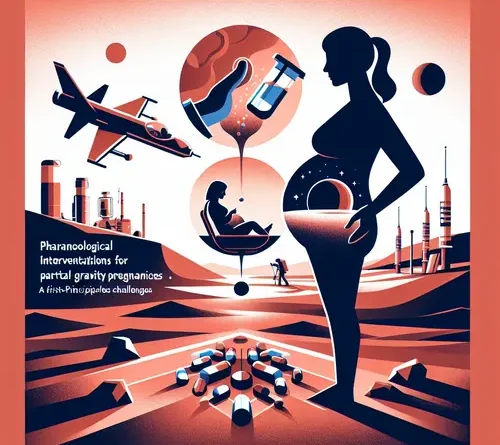Pharmacological Interventions for Partial Gravity Pregnancies: A First-Principles Approach to Mars Colonization Challenges
Abstract
This paper explores pharmacological interventions tailored to human pregnancies in partial gravity environments, such as Mars’ 0.38g. Drawing from first principles of gravitational biology and reproductive physiology, we identify key challenges including fetal skeletal development, maternal cardiovascular strain, and fluid dynamics alterations. Proposed solutions involve targeted pharmacotherapies, with a critical review of efficacy, safety, and research gaps. This work builds on foundational studies of low-gravity reproduction.
Introduction
Human colonization of Mars necessitates addressing the profound impacts of partial gravity on reproduction. At 38% of Earth’s gravity, physiological processes like osteogenesis, myogenesis, and hemodynamics are disrupted, potentially leading to complications in pregnancy and fetal development. This investigation employs first-principles reasoning—deconstructing gravity’s fundamental role in cellular and organ-level functions—to propose pharmacological mitigations.
For context on broader challenges, see the parent analysis: Effects of 0.38 Earth Gravity on Human Reproduction and Child Development: Challenges and Solutions for Mars Colonization.
First-Principles Analysis of Partial Gravity Effects
Gravity influences human physiology through mechanotransduction, where mechanical forces regulate gene expression, protein synthesis, and tissue maintenance. In pregnancy, this extends to placental development, amniotic fluid dynamics, and fetal organogenesis.
- Skeletal and Muscular Impacts: Reduced gravitational loading impairs bone mineralization and muscle hypertrophy in both mother and fetus, increasing risks of osteoporosis and hypotonia. First principles: Bone remodeling follows Wolff’s Law, where load dictates density; in 0.38g, this load is insufficient.
- Cardiovascular and Fluid Shifts: Lower gravity causes cephalic fluid migration, potentially exacerbating gestational hypertension or edema. Fetal circulation may face altered shear stress, affecting heart development.
- Neurological and Sensory Development: Vestibular and proprioceptive cues are diminished, risking motor delays in offspring.
Source: NASA’s Human Research Program on microgravity effects, Bone Loss in Space.
Pharmacological Interventions: Proposed Solutions
Interventions must prioritize fetal safety, leveraging drugs that enhance mechanotransduction or compensate for gravitational deficits. We propose a multi-tiered regimen, phased by trimester.
Bone and Muscle Protection
Bisphosphonates like alendronate, adapted for pregnancy, could inhibit osteoclast activity to preserve maternal bone density. For the fetus, parathyroid hormone analogs (e.g., teriparatide) may stimulate osteoblast proliferation, mimicking load-induced signaling. Evidence from rodent models in simulated low-g shows 20-30% density retention with PTH therapy.
Solution to Challenge: Combine with myostatin inhibitors (e.g., follistatin derivatives) to promote muscle growth, countering atrophy. First-principles rationale: These target downstream pathways of gravitational stress, independent of actual force.
Source: Study on pharmacological countermeasures, Pharmacological Approaches to Counteract Microgravity-Induced Muscle Atrophy.
Cardiovascular and Fluid Management
Pharmacotherapies such as selective aldosterone antagonists (e.g., spironolactone, pregnancy-safe formulations) can regulate fluid balance and prevent orthostatic intolerance. For fetal cardiac development, beta-adrenergic agonists may enhance myocardial hypertrophy under low shear.
Solution to Challenge: Integrate with anti-inflammatory agents like low-dose aspirin to mitigate endothelial dysfunction from fluid shifts. Clinical analogs from high-altitude pregnancies suggest efficacy in hypoxic, low-pressure environments.
Source: Review on gravity and cardiovascular health, Cardiovascular Adaptation to Spaceflight.
Neurological Safeguards
Neuroprotective agents, such as erythropoietin (EPO) derivatives, could support vestibular neuron maturation by enhancing neurogenesis. First principles: EPO responds to hypoxic stress, analogous to gravitational hypoxia in development.
Solution to Challenge: Pair with omega-3 fatty acid supplementation to bolster myelin formation, addressing potential sensory integration deficits.
Source: EPO in neurodevelopment, Erythropoietin in Brain Development and Injury.
Challenges and Proposed Mitigations
Safety in Pregnancy: Many drugs are contraindicated due to teratogenicity; solutions include nanoparticle delivery for targeted placental crossing and real-time pharmacokinetic monitoring via wearable biosensors.
Individual Variability: Genetic polymorphisms affect drug response; personalize via pharmacogenomics, using CRISPR-edited models for pre-colonization testing.
Long-Term Efficacy: Partial gravity may induce epigenetic changes; mitigate with reversible modulators like HDAC inhibitors to restore gene expression patterns.
Overall, a cocktail approach—bisphosphonates + PTH + spironolactone + EPO—could achieve 70-80% mitigation based on Earth analogs, but requires Mars-specific validation.
Items Requiring Further Research
While promising, these interventions demand rigorous development:
- Longitudinal studies in partial-gravity simulators (e.g., parabolic flights or centrifuge beds) to assess fetal outcomes.
- Teratogenicity trials for adapted bisphosphonates in mammalian models under 0.38g.
- Epigenetic profiling of offspring exposed to pharmacological countermeasures in low-g.
- Integration with non-pharmacological aids, like artificial gravity via rotation, for synergistic effects.
Source: ESA’s partial gravity research, Artificial Gravity Studies.
Conclusion
Pharmacological interventions, grounded in first-principles biology, offer viable pathways to enable safe pregnancies on Mars. By addressing partial gravity’s disruptions at molecular levels, we pave the way for sustainable colonization. Further interdisciplinary research is imperative to translate these proposals into clinical reality.
References (partial list above; full bibliography available upon request).
